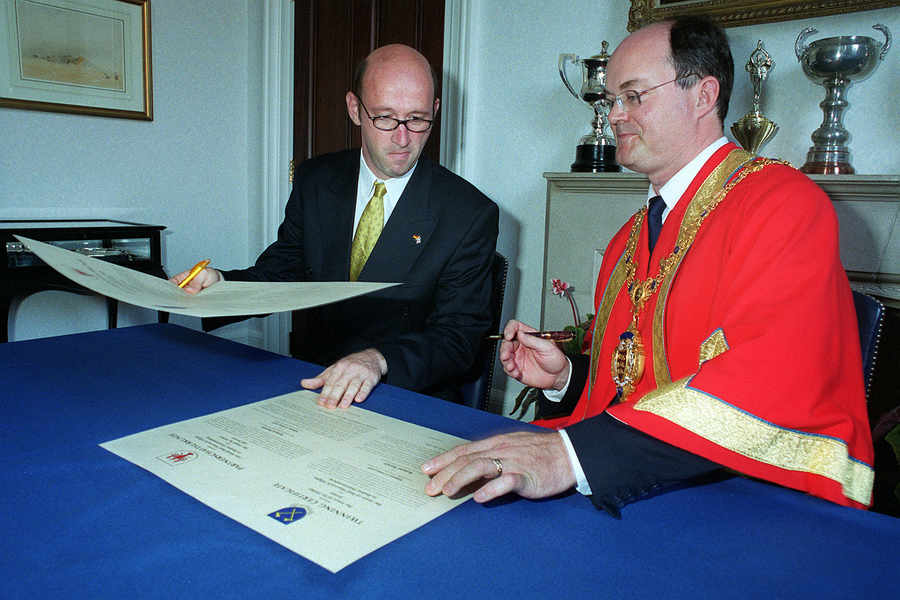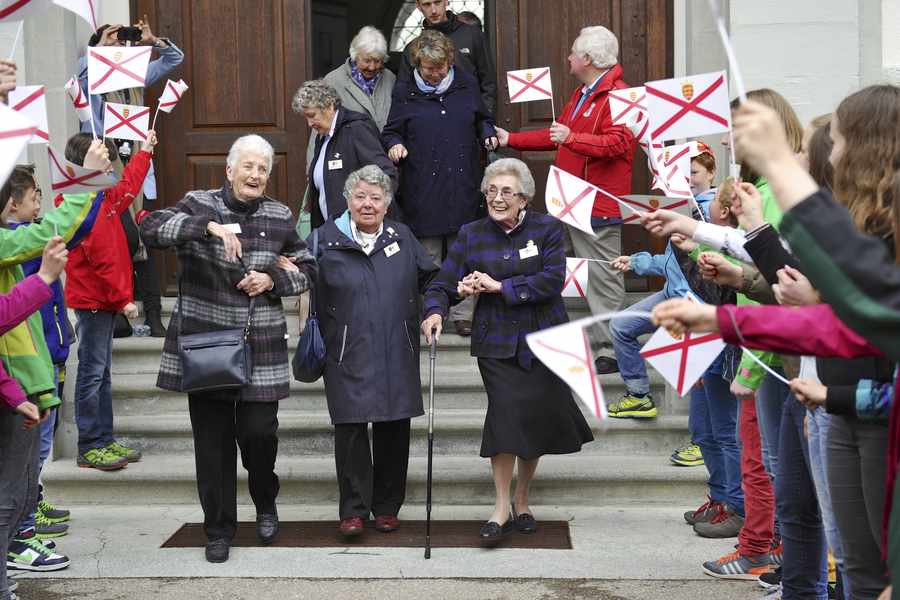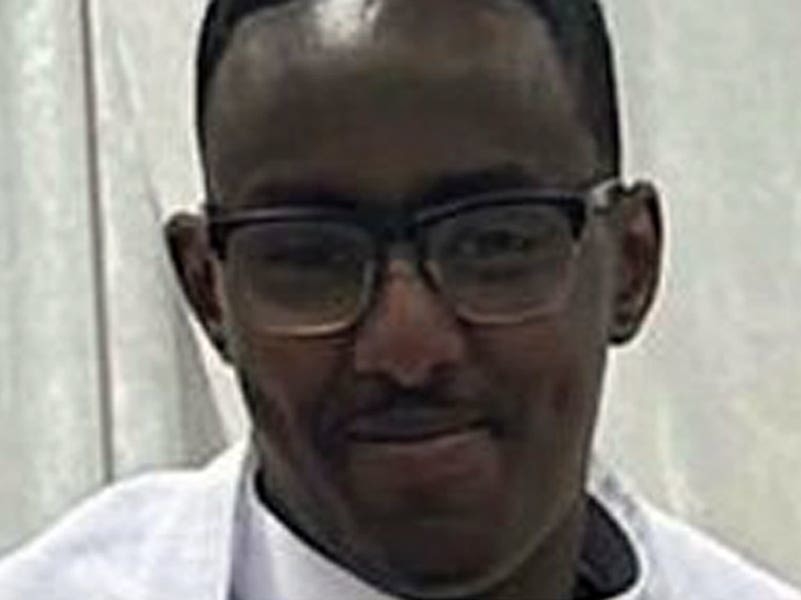- Jersey internees recreate walk to freedom in Bad Wurzach
- Group from the Island on visit to celebrate 70 years of freedom
- Childhood memories of life behind barbed wire – read an interview with a former internee
- Find out more about the town and the Island’s links with it below
ISLANDERS who were detained in Bad Wurzach internment camp during the Second World War celebrated the 70th anniversary of their liberation yesterday – by recreating the walk to freedom they had made seven decades earlier.
Unlike on 28 April 1945, however, as the 11 former internees passed out through the front doors of the town’s 18th-century castle, they were met by crowds of cheering local schoolchildren waving Jersey flags.
Accompanied by friends and family, the ex-internees were earlier given a tour of the Schloss, the place they called home for nearly three years, which is now partly used as classrooms for the town’s college.
Led by Michael Ginns, the 87-year-old Island historian and former internee, the 70-strong party was shown a number of the old bedrooms and told tales of the experiences that the internees had had inside.
They were also shown the building’s magnificent Baroque staircase – a place, Mr Ginns recalled, was used by many of the then teenagers to meet up with their girlfriends and boyfriends, away from the watchful gaze of their parents.
For many of the former internees, the visit brought back jubilant memories of liberation – a moment that signified the end of months of living behind barbed wire.
Collette Falle, who was 13 at the time, said: ‘I was watching from one of the windows as the French tanks came in.
‘When we were allowed to go out, I distinctly remember thinking: “Am I really allowed to step out there?” It really was quite strange having the freedom to do so after so long as prisoners.’
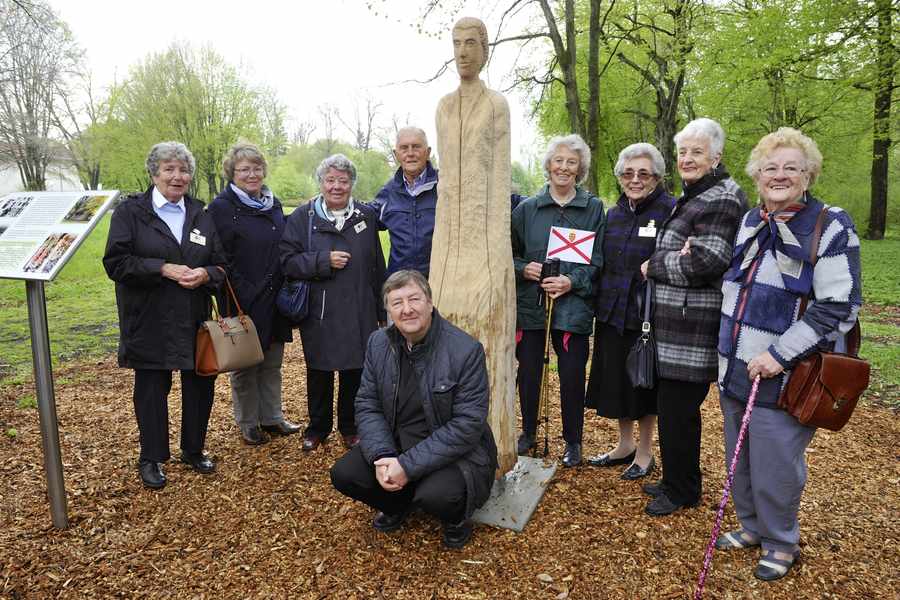
Tony Barnett, who visited the room that he lived in as a boy, said that the experience had given him ‘goosebumps’.
‘It brought floods of memories back,’ he said. ‘It was very touching to see everyone that I used to know and the room that I used to live in with my mother.’
Mr Barnett was accompanied by eight family members, including one of the youngest Islanders on the trip, his grandson Johnny Ashton-Barnett.
Johnny (23) said: ‘We have always heard stories about it, so it’s been really special to come back and see everything in person.
‘We have three generations of our family here and it’s really important for us to keep the stories alive for future generations.’
After the tour, a special wood carving of a figure emerging from a tree trunk was unveiled during a ceremony in the park behind the Schloss.
Commissioned to mark the 70th anniversary of the Liberation, English artist Robert Koenig described his tree sculpture as symbolising a ‘silent witness of past events in the town’.
The day culminated in an official dinner in the Schloss, which featured a rendition of Beautiful Jersey by the Constable of St Saviour, Sadie Rennard.
The event was also attended by the Bailiff, William Bailhache, and Bad Wurzach’s mayor, Roland Bürkle
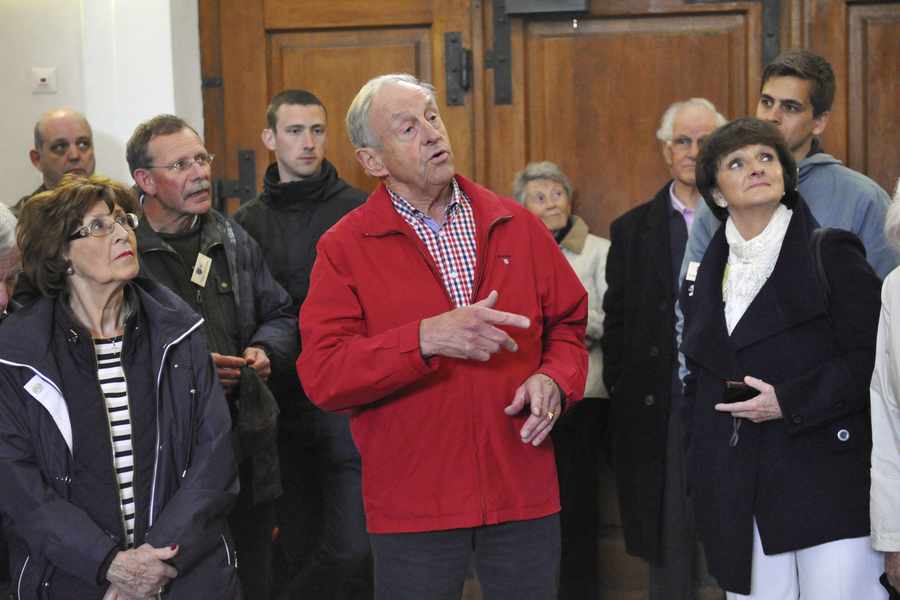
Tuesday marked 70 years since French army tanks rolled into Bad Wurzach, a small town in southern Germany, to liberate hundreds of Jersey internees.
A total of 618 Islanders were held captive by German forces in the town’s 18th century castle between 31 October 1942 and 28 April 1945.
And exactly seven decades to the day they walked to freedom as children and teenagers, 13 ex-internees, together with friends and family, re-entered the building they called home for two-and-a-half years.
For many of the former internees, who are now in their seventies and eighties, it will be the last time they venture into the Schloss, following the decision that this is to be the final official organised trip from Jersey.


- Bad Wurzach is a small town in southern Germany and is part of the Ravensburg district.
- The towns castle Schloss Bad Wurzach was used to detain Channel Islanders during the Occupation.
- In 1950 the town was given the prefix Bad, indicating that there was a therapeutic bath house there.
- After the development of the towns urban spa service in 1948 Bad Wurzach became known as a major health resort within the region.
- It has thermal spas, indoor and outdoor swimming pools, hiking trails, several sports grounds and a petting zoo.
- It covers an area of just over 70 square miles and has a population of 14,167.

70 years ago today, Pam Tanguy walked out of Bad Wurzach internment camp to freedom after it was liberated by French troops. She told the JEP about her experiences as a young girl living under enemy rule far from home
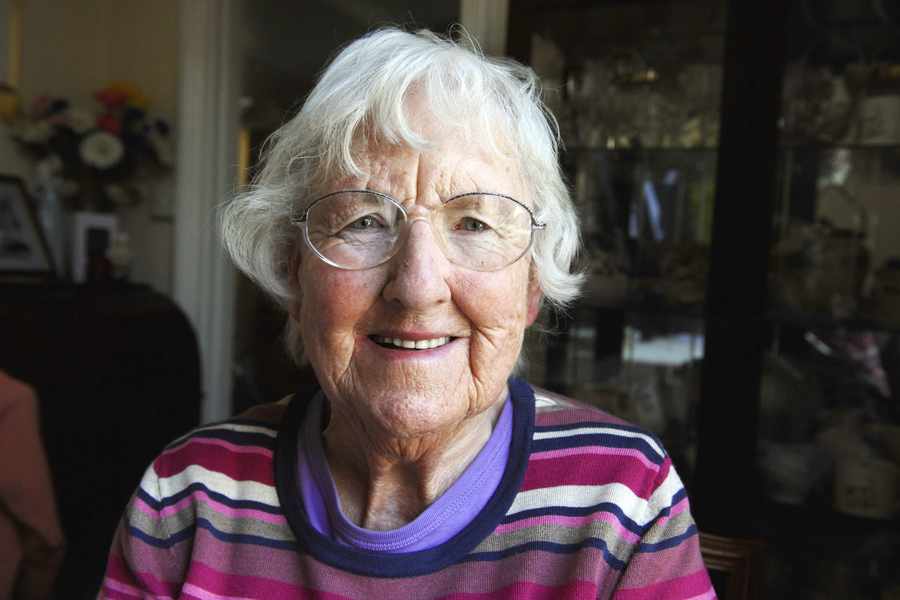
‘SHOULD you fail to obey this order, punishment by court martial will be effected.’
These were the menacing final words of a notice issued to dozens of UK-born families that demanded their immediate deportation to Germany on 16 September 1942.
Less than 24 hours later, six-year-old Pam Tanguy and her parents were shipped off Jersey, with no clue where they were heading or what the future might hold.
Pam, who is now 78, has vivid memories of the night she left.
‘The trip across the Channel was horrendous,’ she said. ‘We weren’t taken until it was dark because Allied planes would have bombed any shipping.
‘We were in the hull of a coal boat with just a canvas over us in the pitch black, and you could feel the water splashing in on you.
‘It was a very choppy crossing and I remember wearing a Mae West life jacket made from canvas and wood and feeling absolutely terrified.’
It would be several weeks before Pam, who was recovering from pneumonia, would reach Bad Wurzach in southern Germany – where she would be interned in the town’s 18th-century Schloss for the next two and a half years.
Although she says she was not unhappy in the camp, her life was certainly different from what it had been in her Grouville home.
Pam, who was officially prisoner 501, lived with 36 other women and children in one corner of a large room.
Because her father worked in the laundry room she had an added luxury – the use of a cement basin for her and her mother to bathe in.
Otherwise, she says, conditions were very basic. ‘The mattresses were made of straw and they were full of fleas. It was absolutely filthy when we got there and I remember some of the adults using pieces of glass to clean the floors. They were given de-lousing powder to spread on the beds, but my father still used to say he never got a night’s sleep.’
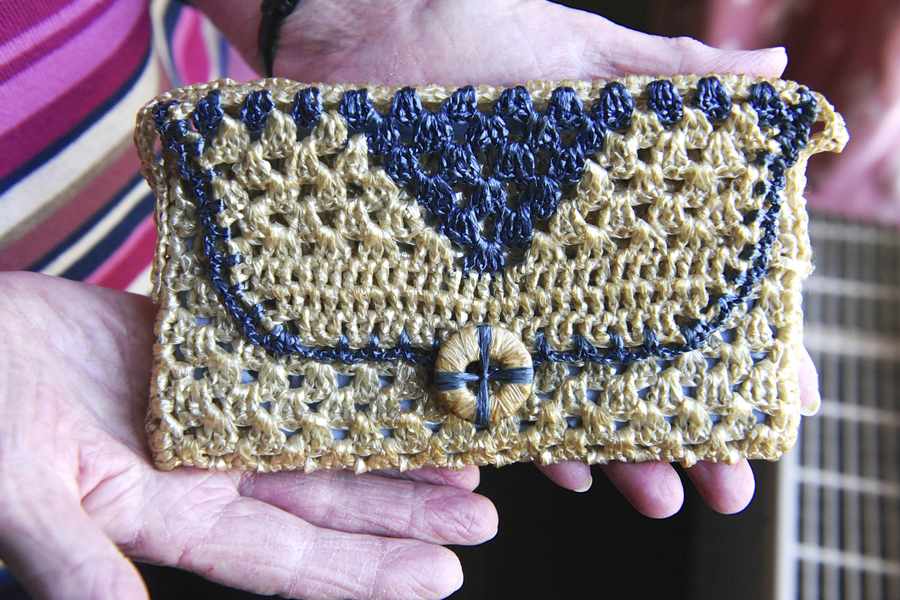
If it had not been for a special Red Cross package, Pam says that she would have left the camp with very basic literacy skills.
The two books that were inside that parcel – These Are Our Neighbours and The Little Black Hen – she still has to this day and they are among her most treasured possessions.
‘My dad taught me how to read using those books and to count by playing cribbage from a board that he put together.’ she said. ‘I must have read those books dozens of times because lessons were very few and very far between.’
Food was also a problem and she says the internees had to improvise in order to get the nutrients they required.
‘There were no vegetables whatsoever,’ recalled Pam. ‘I remember picking the green leaves off the dandelions with my mother when we went on walks outside the Schloss.
‘We used to eat that – dandelion leaves were our greens. How our chef made soup for a few hundred people goodness only knows.’
Pam was ill for much of her stay in Bad Wurzach, suffering from yellow jaundice just a short time after she had recovered from pneumonia. She was, however, luckier than another young girl.
‘I was very friendly with Geraldine Barnes, and we used to play together quite a bit.
‘I can remember my mother saying, “You won’t be seeing Geraldine because she has died”. I might have been seven and she might have been five. I’ve been back and cried my eyes out at the cemetery where she was buried.’
It is one of a few memories that, she says, still haunt her today.
‘As children we used to run around all over the place,’ she said. ‘On one occasion I’d been down at the front of the building and I came back to my room up a spiral staircase.
‘I was on my own and down came an SS officer – he was in a leather mac and had a huge Alsatian guard dog. I just stood back against the wall. I didn’t say anything and thankfully he passed, but it still sends shivers down my spine.’
She remembers the ‘smashing’ of the gates by the French troops who liberated the camp on 28 April 1945, but a moment not long after that has more of a hold on her memory.
‘We were the last to leave, because Whiting was our surname. We lived in a nearby hangar for a while, and the men were out in tents. During that four or five days, in came French planes with people from Bergen-Belsen and I saw rows and rows and rows of people on the airstrip. I can remember seeing this all happen and they made us leave in case we caught any illnesses from them.’
Since then, she has returned to the camp four times, but on this occasion her son Steven, daughter-in-law Jane and grandson
John have joined her on the trip to Bad Wurzach. Today she will lead three generations of Tanguys in through the gates of the grand old building and then out, marking 70 years to the day that she walked to freedom with her parents.
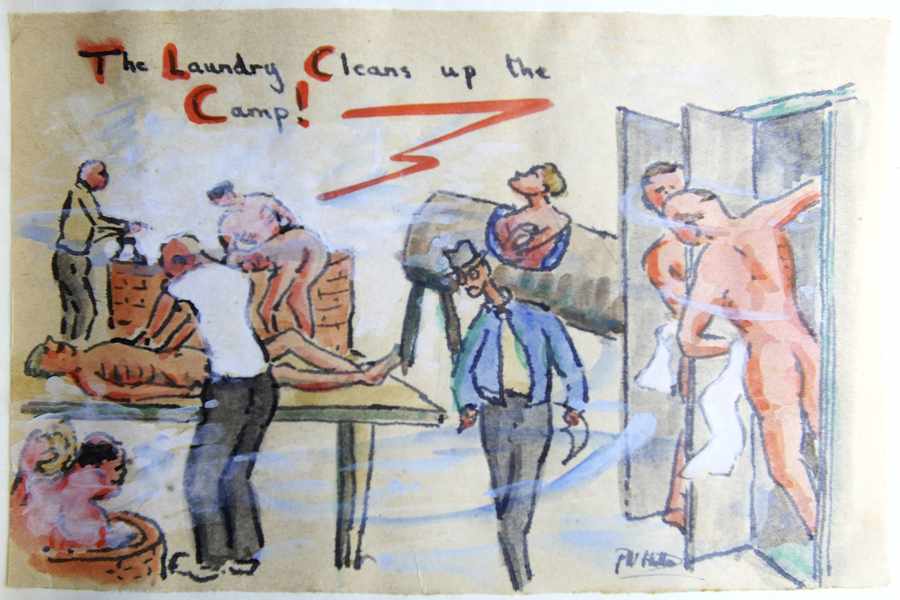

JERSEY’S unique connection with Bad Wurzach began during the Second World War when 618 men, women and children were removed from the Island and moved to the German town.
They became internees of the camp as they were UK born or had UK-born parents and over the course of the war more than 2,000 Channel Islanders were detained in Germany for nearly three years.
Those in Bad Wurzach, where supplies were scarce, were liberated on 28 April 1945. Guernsey internees, who were kept in the nearby camp of Biberach, were freed a few days earlier on 23 April of the same year.
In the years that followed a group of Islanders including former internees began to return to Bad Wurzach each year in celebration of their liberation.
They forged ties with the region and after forming the St Helier Bad Wurzach Twinning Association Jersey’s capital and the small German spa town were linked in 2002.
Formal yearly trips were organised and often saw the Bailiff, religious leaders and senior politicians join the trips to the region at the end of April.
However, it is likely that this year’s trip will be the last group journey for many of the former internees who agreed that the 70th anniversary visit would mark their final return to Bad Wurzach.
